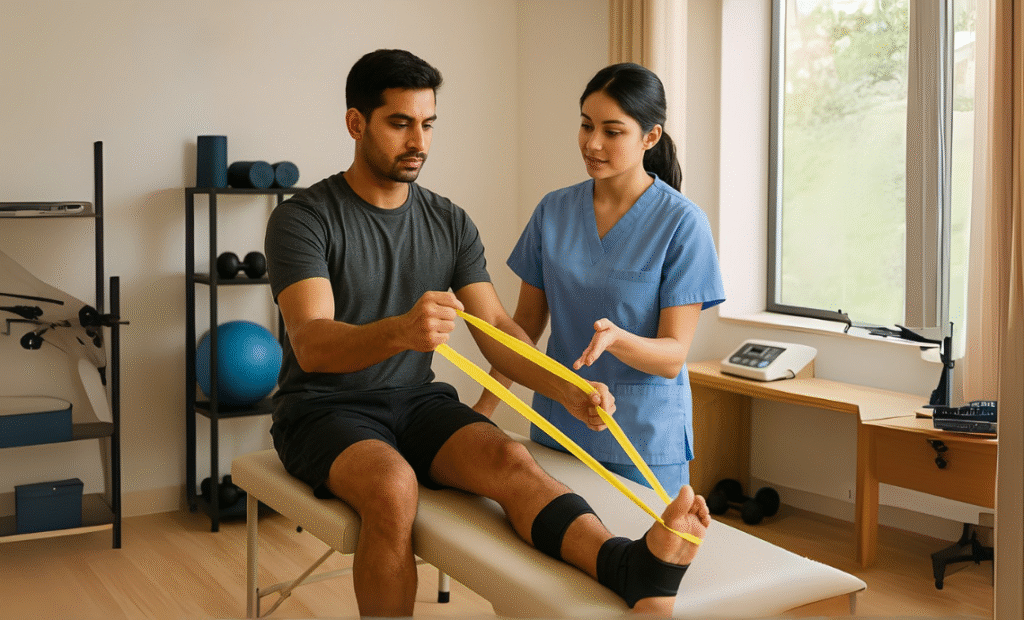Physiotherapy for sports injuries is more than just pain relief—it’s a structured path to recovery, strength, and prevention. Whether you’re a professional athlete or someone who plays on weekends, an injury can disrupt your routine and well-being. At Violet Physio, we specialize in helping you bounce back stronger with scientifically-backed rehabilitation plans tailored to your needs.
1. What Is Physiotherapy for Sports Injuries?
Physiotherapy for sports injuries combines expert evaluation, manual therapy, and personalized recovery plans to promote healing. A skilled sports physiotherapist assesses the extent of your injury, addresses any underlying biomechanical issues, and crafts a plan that includes hands-on therapy and progressive injury rehab exercises.
From ACL recovery physiotherapy to tennis elbow treatment, every approach is built around your unique condition and athletic goals.
2. Early Recovery: Pain Relief Without Heavy Meds
The first step in physiotherapy for sports injuries is controlling pain and inflammation. Using techniques like dry needling, ultrasound, ice therapy, massage, and TENS, a sports physiotherapist helps reduce discomfort and swelling. This allows you to begin movement therapy early—kickstarting the recovery process without over-reliance on medications.
3. Tailored Exercise Plans for Long-Term Healing
Injury rehab exercises are at the heart of sustainable recovery. Each program is designed to rebuild strength, restore flexibility, and promote tissue repair.
ACL Recovery Physiotherapy
Our four-phase plan is aligned with international best practices:
- Phase 1 (Weeks 0–3): Control swelling, regain range of motion, initiate quad activation
- Phase 2 (Weeks 3–8): Strengthen hips and quads, introduce balance drills
- Phase 3 (Weeks 8–12): Begin plyometrics, running, and agility work
- Phase 4 (Months 4–9+): Gradual return to sport based on strength and stability tests
Tennis Elbow Treatment Protocol
We focus on progressive loading and pain management:
- Phase 1: Rest and icing
- Phase 2: Isometrics and soft-tissue mobilization
- Phase 3: Eccentric wrist exercises and extension curls
- Phase 4: Functional grip and sport-specific movements
These protocols showcase how physiotherapy for sports injuries uses phased rehab to speed up recovery and reduce the risk of setbacks.
4. Every Exercise Counts
Active participation is key in physiotherapy for sports injuries. Every supervised movement increases circulation, oxygen delivery, and tissue repair. Unlike passive treatments, these hands-on approaches stimulate healing and improve functional outcomes.
5. Regain Strength, Flexibility & Mobility
Injuries often lead to restricted range of motion and muscular imbalances. Through targeted stretching, joint mobilization, and strengthening, physiotherapy for sports injuries restores full function. We aim to prevent compensatory movements that can trigger new problems.
6. Fixing Biomechanics to Prevent Reinjury
A major focus of physiotherapy for sports injuries is correcting movement faults. Whether it’s your running gait, shoulder mechanics during a throw, or posture during lifting, a trained sports physiotherapist will assess and improve your technique. This minimizes strain on affected areas and builds resilience.
7. Sport-Specific Training
Returning to your sport safely is the final goal. Our approach to physiotherapy for sports injuries includes drills that replicate game-time scenarios—like plyometrics after an ankle sprain, racket-motion drills for tennis recovery, or jump training post-ACL. This kind of functional rehab is crucial for athletic performance.
8. Mental Motivation & Support
Rehabilitation isn’t just physical. Injury can shake your confidence and affect your mindset. At every stage of physiotherapy for sports injuries, we provide encouragement, track your progress, and help you stay focused. This emotional support keeps you committed and consistent.
9. Real-Life Recovery Examples
We’ve seen remarkable recoveries through structured injury rehab exercises, whether it’s an athlete back on the field post-ACL surgery or a working professional pain-free after tennis elbow treatment. These real-world stories highlight how effective physiotherapy for sports injuries can be with the right plan and expert guidance.
Why Choose Violet Physio?
At Violet Physio, we’re redefining recovery through precision care. Here’s what we offer:
- Personalized evaluations by experienced sports physiotherapists
- Advanced manual therapy and cutting-edge modalities
- Progressive injury rehab exercises tailored to your sport and condition
- Specialized programs like ACL recovery physiotherapy and tennis elbow treatment
- Ongoing motivation, support, and injury prevention education
Final Takeaway
Physiotherapy for sports injuries isn’t about slowing down—it’s about moving forward the right way. From easing pain quickly to building long-term strength and resilience, our method empowers you to recover with confidence and clarity. Through expert manual therapy, targeted injury rehab exercises, and guidance from a skilled sports physiotherapist, you’ll experience faster healing, improved mobility, and reduced risk of reinjury. Our functional, sport-specific approach ensures you’re not just pain-free—you’re game-ready. Plus, with ongoing motivation and mental support, you’re never alone in your journey.
Take the first step with Violet Physio—your recovery begins today.


